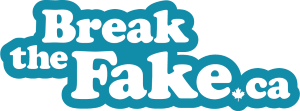Break the Fake Tip #2: Find the source
- The easiest way to find the source is usually to follow links that will lead you to the original story. In social media like Facebook or Twitter, the link is usually at the end or bottom of the post.

On a website, follow links that lead back to the source. Look for phrases like “According to” a source, a source “reported” or the word “Source” at the top or bottom of a story. Like in this example below – click on highlighted words “Associated Press”:

Make sure to keep going until you’re sure you’re at the original!
- You can also use a search engine like Google or DuckDuckGo. See if you can find any information about where the story originally came from and do a search like this:

- To find the original source of a photo or image, you can use something called reverse image search. Start by right-clicking on the image and selecting the option “Copy Image Location.” Then go to the website Tineye.com and paste in the address you just copied and sort the results to show the oldest first. See the example below:



- On a Mac, hold down Control while clicking instead of right-clicking.
- On Chrome and Safari, select Copy Image Address.
- On Edge, select Copy.
If you don’t know if the original source is reliable or not, use the Verify the Source tip sheet to find out.
If you can’t find the original source, use the Check Other Sources tip sheet to see if the story is for real.
Make sure to take these steps to double-check before you share anything we see online, every time. Because only you can break the fake.

This tip sheet is part of the Break the Fake project. This project has been made possible in part by the Government of Canada.
